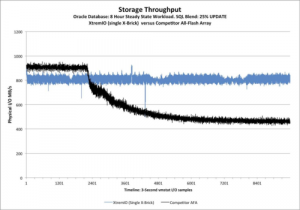DBA notice things like latency, especially if you’re able to deliver low latency one day, or hour, and not the next. Of course, Flash promises performance, no rotational delay, no seek-time. Performance is the easy part; I’ll say it again, Architecture Matters. Without getting on my soap-box, Flash impacts every storage architectural model. Flash is everywhere.
XtremIO takes the concept to a new level. By developing a storage architecture designed from the ground up to take advantage of Flash, you can develop an architectural model that addresses the shortcomings of Flash; Shortcomings like garbage collection, memory management and write wear leveling. If not addressed, these shortcomings can lead to inconsistent performance, regardless of architecture.
The XtremIO engineering team recently pointed out these shortcomings and how XtremIO is architecture to directly address them. Looking at a specific workload, in this case Oracle Databases, it starts to become clear how XtremIOs in-memory meta-data can provide constant performance in an environment that provides a wide variance of IO profiles and patterns.
 The White Paper “EMC XtremIO Optimized Flash Storage for Oracle Databases” looks at the principles of Oracle Databases and how “All Flash Array” technologies can be used to solve those issues, while maintaining consistent performance characteristics.
The White Paper “EMC XtremIO Optimized Flash Storage for Oracle Databases” looks at the principles of Oracle Databases and how “All Flash Array” technologies can be used to solve those issues, while maintaining consistent performance characteristics.
While the general category “All Flash Array” may include many offerings, the implementation of each is much different. When running real Oracle Benchmarks like SLOB, you can clearly see what we mean by consistent performance.
Download the whitepaper for yourself at https://www.dell.com/favicon.ico?xtremio.comhttps://www.delltechnologies.com/uploads/2014/07/h13174-wp-optimized-flash-storage-for-oracle-databases.pdf
As always, follow me on twitter @SamMarraccini, check out my YouTube channel and if you are headed to VMWorld2014 (San Fran), drop me a tweet and be sure to stop by the EMC Booth!